Archived Storm Damage Blog Posts
Winter Weather Safety for Your Georgia Home: Protecting Your Property in the Peach State | SERVPRO of Carrollton
1/8/2025 (Permalink)
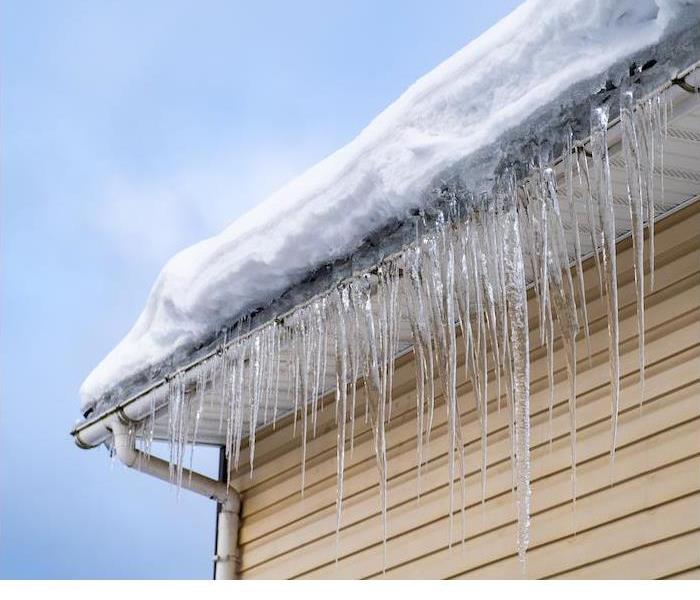 Winter Weather Safety: Protect your Georgia home from winter risks with SERVPRO's expert tips!
Winter Weather Safety: Protect your Georgia home from winter risks with SERVPRO's expert tips!
While Georgia is known for its mild winters, the state’s unpredictable weather can still pose challenges for homeowners during the colder months. From sudden freezing temperatures to unexpected ice storms, it’s important to be prepared for any situation.
At SERVPRO of Carrollton, we want to help you keep your home safe and secure during Georgia’s winter weather. By taking a few precautionary steps, you can avoid costly damages and ensure your home stays warm and protected, no matter what nature has in store.
Prepare for Freezing TemperaturesThough Georgia’s winters are generally mild, temperatures can still drop below freezing, particularly in the northern parts of the state. When this happens, pipes are at risk of freezing, especially in homes that aren’t built to withstand such cold. Frozen pipes can lead to significant water damage, causing flooding and expensive repairs.
To avoid this issue, it’s crucial to insulate pipes in areas prone to cold, such as attics, basements, and crawl spaces. Simple pipe insulation can save you from potential damage. During periods of extreme cold, leave faucets dripping slightly to keep water moving through the pipes. Open cabinet doors under sinks to allow warm air to circulate around the pipes, especially those on exterior walls. Taking these simple steps can prevent freezing and save you from dealing with the consequences of burst pipes later.
Protect Your Roof and GuttersGeorgia homeowners aren’t typically accustomed to the heavy snow and ice that northern states experience, but winter weather can still lead to dangerous conditions, such as ice dams and clogged gutters. Ice storms, although rare, can bring an accumulation of ice and snow that adds extra weight to your roof and gutters. If your gutters are clogged with leaves or debris, they might not be able to drain properly, leading to ice buildup, water damage, or even roof leaks.
Before winter arrives, it’s essential to clean your gutters to allow proper water flow during rainstorms or after a freeze. Inspect your roof for any missing or damaged shingles that might leave your home vulnerable to leaks. By ensuring your roof and gutters are in good condition, you can minimize the risk of damage during winter weather events. A well-maintained roof will also help you avoid costly repairs that could arise from ice and water infiltration.
Maintain Your Heating SystemWhile Georgia doesn’t see the extreme cold that other regions face, temperatures can still dip low enough to require heating your home. A malfunctioning HVAC system during the winter months can make your home uncomfortable and costly to heat. To avoid unnecessary repairs or even a breakdown, it’s essential to maintain your heating system regularly.
Before the colder months hit, schedule an inspection of your furnace or HVAC system to ensure it’s functioning properly. Change the filters to improve air quality and efficiency. If you use a fireplace, be sure it is cleaned and inspected to prevent any fire hazards. Keeping your heating system well-maintained will help your home stay comfortable and energy-efficient while reducing the risk of emergencies caused by malfunctioning equipment.
Stay Safe and ProtectedWhile winter in Georgia is often mild, it’s still important to prepare for the occasional cold snap or ice storm. Simple steps like insulating pipes, cleaning your gutters, and maintaining your heating system can help protect your home from damage and ensure you’re ready for any weather that comes your way.
At SERVPRO of Carrollton, we are dedicated to helping Georgia homeowners stay safe and protect their property during winter. If you experience damage from winter weather, whether it’s frozen pipes, roof leaks, or heating system issues, we are here to assist.
Contact us today for expert cleanup and restoration services to get your home back to normal quickly and efficiently. Stay warm, safe, and protected this winter!
Stay Safe When Lightning Strikes
7/10/2023 (Permalink)
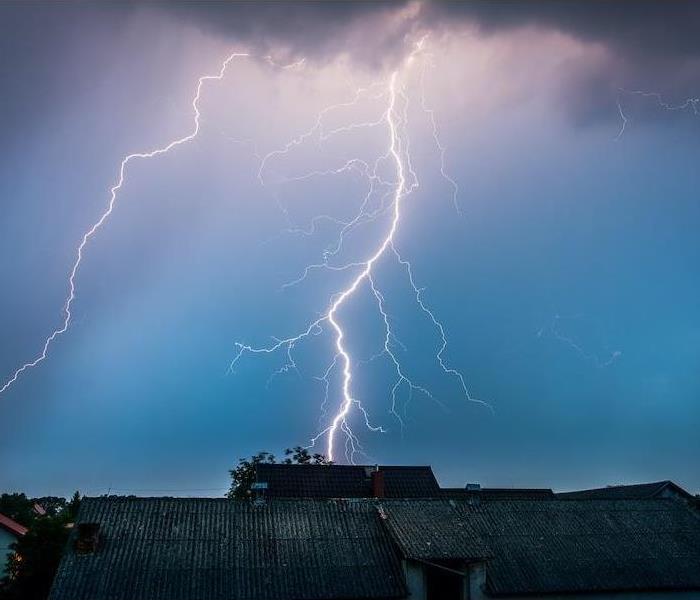 If your home has been damaged by a storm, contact SERVPRO of Carrollton 24/7 to get the recovery process started.
If your home has been damaged by a storm, contact SERVPRO of Carrollton 24/7 to get the recovery process started.
While lighting striking your home may seem like a rare phenomenon, it’s way more common than you’d think. Each year, one in 200 homes is struck by lightning, and there are around 20 lightning-related fatalities annually in the United States.
Knowing what to do and where to go during storms is the best way to protect yourself from this hazard that is created by severe weather. Lightning can not only be a danger to humans but to homes as well. While the path of lightning is unpredictable, knowing the facts can help you best avoid these unexpected bolts from the blue.
The Facts About Lightning
Lightning is a strong sudden burst of electricity, which can travel at about 220,000,000 mph!
Lighting is usually produced during thunderstorms and is more likely to develop during the spring and summer seasons.
While lightning can touch down near or inside your home and create flames, it doesn’t have to strike your home to damage it. When lighting strikes items near your home such as concrete or your gutters, it can surge your home’s electrical system.
A direct hit can also cause damage to electrical and non-electrical items inside your property or severely damage your home’s foundation, chimney and roof.
Here’s how to protect yourself and your home:
Safeguard your home. The simplest way to protect the inside of your home from lighting is by unplugging all electronics before a storm or as soon as you hear a clap of thunder. Lightning is capable of ruining phones, computers and even that fancy new television you just bought.
There are other effective ways to defend your property, but they may be more costly. Of course, approaches such as installing lightning rods on your roof, grounding your home and investing in surge protectors to protect electronics are still beneficial. These precautions could significantly reduce your risk of exterior property damage from lightning.
Know where to shelter. A safe shelter is essential for avoiding lightning. Seek shelter in an enclosed building or a car with a hard-topped roof. If you happen to be outside during a storm and you are unable to seek shelter indoors, avoid bodies of water and shelter near lower trees.
The best way to know when it’s safe to leave your shelter is by listening for thunder. Wait about 30 minutes after hearing a clap of thunder before returning outside.
Unplug your stuff. As stated above, it’s crucial to unplug any electric devices before a storm touches down in your area. If lightning were to strike a nearby electrical pole, it could lead to an electrical surge and completely fry any plugged-in devices.
Making sure to do this ahead of storms is crucial because unplugging equipment during storms puts you at risk of being electrocuted. Staying weather-aware can help you know when it’s time to unplug any devices and seek appropriate shelter.
If your home is impacted by any weather hazards like lightning, our professionals at SERVPRO can be on the scene fast. We have years of experience restoring storm-damaged homes to their preloss state.
How to Prepare Your Home for Severe Weather
6/23/2022 (Permalink)
The weather can be unpredictable. Severe storms that bring floods, heavy winds, hail and other hazards can suddenly sweep through and destroy lives. That’s why it’s advisable to take precautions around the house ahead of time to minimize damage.
Water damage and ruined infrastructure are the most costly consequences of a strong storm. And it can be costly—the national average cost of repairing your home after a storm is around $9,800. Preparing your Conyers home before storm season could save you money in the long run.
Start with these precautions you can take around your home to secure it before a storm:
Keep valuables safe. Flood water is notorious for ruining valuables within the home. Items such as family photos, clothing, heirlooms and other valuables can be protected from water damage by storing them in a watertight container. Keep them up high, preferably on a shelf or in your attic, where floodwater can not reach them.
Secure your roof. Your roof protects the interior of your home by keeping water out. When preparing for a storm, it is critical to reinforce your roof. Keep it well-maintained by nailing down or replacing any loose shingles. Once a storm has passed, have the roof inspected to ensure it’s still in good, working condition.
Clean your gutters and downspouts. July is usually the wettest month in Conyers, but storms can arrive at any time, bringing heavy rain that will rush through your gutters. When functioning optimally, the gutters and downspouts keep rainwater from running down the sides of your house and causing structural damage. Be sure to clear them of any leaves, twigs and any other debris to keep the water flowing.
Do some yard work. Cleaning up around the lawn can keep trees and debris from falling on your house during high winds. Trim any large branches that reach for your roof or are close to your house since they can break off and damage anything in their path. Clear dead plants, branches or shrubs to keep strong winds from blowing them against your windows or walls.
You can’t completely avoid storms, but you can do everything you can to protect yourself and your house. Regular weather maintenance and awareness is an effective strategy to safeguard your belongings and property from the consequences of severe storms.
If your home has been affected by water or infrastructure damage as a result of a major storm, we specialize in home restoration. Contact us right away, and we can restore your home to its preloss condition.
Storm Preparation Can Save Your Life
6/8/2022 (Permalink)
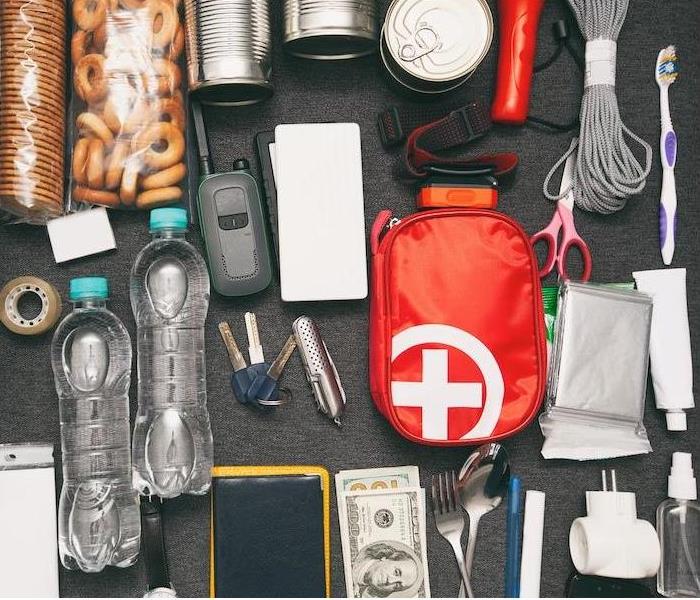 Storm preparation can save your life, let SERVPRO help you get ready.
Storm preparation can save your life, let SERVPRO help you get ready.
When a severe storm warning is issued, you race to prepare, unsure of what to do first to keep you and your family safe. Preparing for storms ahead of time can keep you from having to rush to make a plan.
But with that in mind, 42% of Americans say they do not have an evacuation plan in place. A lack of preparation for an impending storm puts you at risk of the storm’s fatal effects.
Here are a few steps you should take ahead of time to prepare:
Develop a safety plan. The first step in storm preparation is to create a safety plan. Make a household meeting place and, in the event of an evacuation, know where you need to go. Make sure that everyone in your household is aware of any impending weather events and what they can do to stay safe.
Pack an emergency kit. Having an emergency kit on hand ensures that all of the essential items you may need in the event of an emergency or evacuation are all in one place. Items such as emergency food and water, medical supplies, flashlights, and a first-aid kit should be included. Keep your kit in a location where everyone in the house can access it when needed.
Prepare valuable possessions. Flood water can enter your home during severe storms, and if your belongings aren’t in a safe area, they might be ruined by water damage. Passports, birth certificates, family photos and any other items that are too important to lose should be stored in a plastic bag or a waterproof container.
Stay informed. Keep an eye out for local weather alerts to get ahead of any approaching storms. You can stay up to date on current weather events by listening to local radio and television stations. Make sure you understand the difference between a storm warning and a storm watch, as they require distinct preparation measures.
Find a safe place to stay. If you need to shelter in place, stay in your basement or an interior room with no windows. If you feel you need to find a safer place to shelter, you can search for a local mass care shelter to evacuate to. Wherever you find yourself during a storm, be sure to always bring your emergency kit.
When severe storms damage your property, quick action can prevent further damage. SERVPRO is available 24/7 to repair storm damage of any size ASAP.
Do You Have a Plan for Staff Safety in Severe Weather?
4/8/2022 (Permalink)
 Do you have a Plan for Severe Weather? Reach out to SERVPRO of Carrollton today.
Do you have a Plan for Severe Weather? Reach out to SERVPRO of Carrollton today.
Severe weather can be an extremely dangerous thing. Not only is it often unpredictable, but it is also quick-moving—meaning waiting to prepare when it becomes imminent can put you in harm’s way.
If you are a business owner, preparing in advance is even more important, as it will help you keep both yourself and your staff safer in the event of weather concerns.
If you have not yet put together a plan for severe weather, now would be the time to do so. Not only is it a requirement from OSHA that you have an emergency action plan in place, but it is also a smart way to keep everyone calm and comfortable even when the weather goes south. There are a lot of key elements in emergency planning, but below, we will focus specifically on some things to consider to keep your staff safe.
How to Keep Your Staff Safe During Severe Weather
**Make planning a collaborative process.** Having an emergency action plan is great, but it does not do much good for your organization if no one is aware of what the plan is. Make sure you include your staff in the planning process and keep them aware of what protocols to follow should severe weather become imminent.
**Make sure everyone’s needs are accounted for.** It is a good idea to pack a general emergency kit for your workplace to cover things like flashlights, first-aid supplies and general items to keep everyone comfortable in the event of a power outage. However, you should also encourage staff to have their own personal emergency kits that meet their needs—that way, if there is an emergency scenario, they will have access to necessities such as medication and personal items.
**Make it clear where everyone should go.** In the event of a severe weather event, you and your staff will need to seek shelter on-site until the threat passes. Be sure you have a safe area clearly identified so staff know exactly where to go. This area should not have any windows or external-facing walls, and ideally will be at or below the building’s ground floor.
*If your building has damage due to severe weather, we are the team to call! Contact us today to learn more about our storm restoration practices.*
What Is Your Business’ Storm Readiness Plan?
4/8/2022 (Permalink)
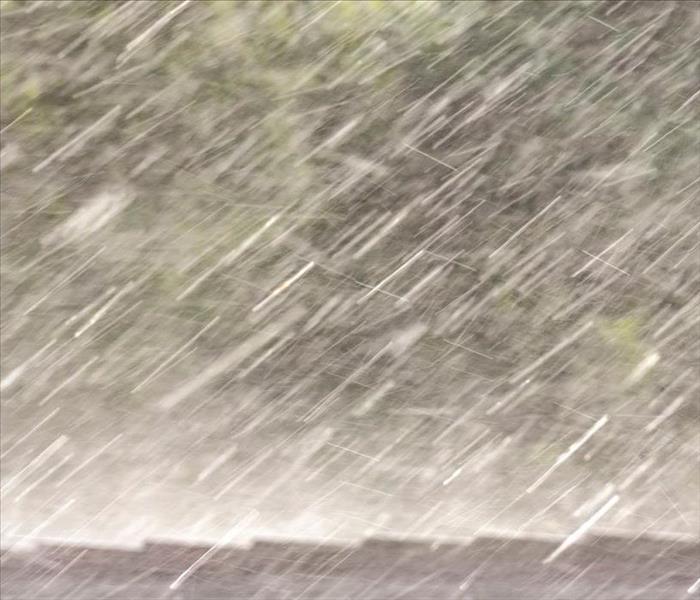 If you need help getting your business prepared for a storm, call SERVPRO of Carrollton
If you need help getting your business prepared for a storm, call SERVPRO of Carrollton
A severe storm is an unpredictable thing—with atmospheric uncertainty and ever-changing conditions, the timeline and severity of a storm can often be in question until the moment it moves into an area.
However, this uncertainty is not an excuse to not be prepared. In fact, it is all the more reason for business owners to put a plan into place. Not only does OSHA require all employers to draft a written emergency action plan to comply with their standards, but it is also a good idea from a practicality standpoint. Below, we will take a look at some key elements of your storm readiness plan to include so you can keep yourself and your employees as safe as possible should the weather turn dangerous.
What Do I Do for My Business’ Storm Readiness Plan?
**Create an emergency kit in case weather strikes on the job.** Unfortunately, storms never adhere to a convenient schedule, meaning the odds are high that one may strike while everyone is actively in the office. If this is the case, keeping everyone safe and comfortable is top priority while you wait for the storm to pass. An office emergency kit, which should include food, water, flashlights and a weather radio at minimum, will keep everyone comfortable should the power go out and require you to stay put until the threat is over.
**Communicate with your employees.** Trying to communicate instructions and convey new information in a stressful scenario is never ideal, so take this opportunity to communicate with your employees in advance so they are aware of the severe weather protocol. Let them know what your plan is, where they should seek shelter in bad weather and what to expect in an emergency scenario.
**Protect your business’ data.** Because most things are digital now, rain can be quite dangerous to business data. Be sure that your data is backed up, either on an external hard drive or in the cloud, so it can be retrieved even if key computers get water damage due to severe weather.
*If your business sustains damage due to a storm, we are the team to call. Get in touch with us today to learn more about how we can help.*
Potential Spring Weather Hazards Across The Country and Close to Home
4/4/2022 (Permalink)
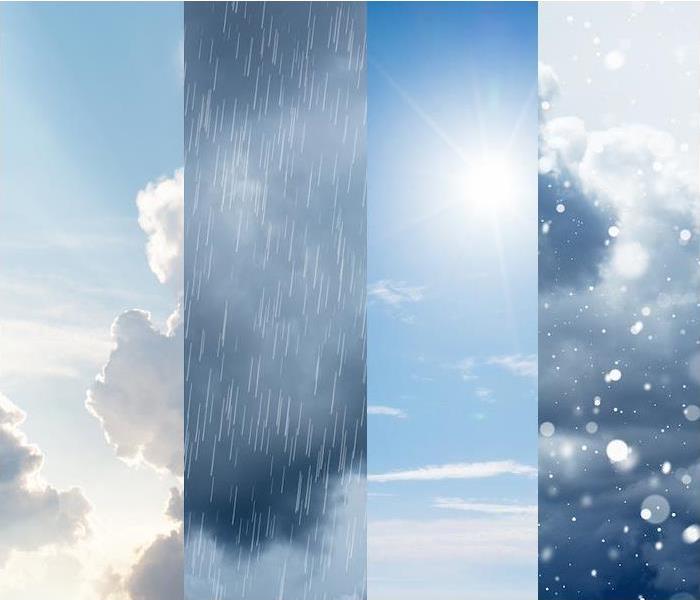 Extreme temperature changes can lead to the possibility of severe weather. SERVPRO of Carrollton is a click away if you experience any damage.
Extreme temperature changes can lead to the possibility of severe weather. SERVPRO of Carrollton is a click away if you experience any damage.
The United States is the third largest nation in the world, coming in behind Russia and Canada based on land mass.
When you have such a large geographical area encompassed in one country, “spring weather” season can have a much different meaning depending on where you are. There are all types of different weather events, which means there will also be different weather threats.
With spring right around the corner, read on for a look at what different parts of the country can expect, weather-wise.
First, let’s take a look at the Pacific Northwest region. The residents here experience heavy rainfalls during the spring months, causing flooding and water damage. There are areas with high elevations that may be dealing with a different type of wet weather—remnants of snow or ice melting, which cause problems of their own.
Now looking at the Upper Midwest and Northeast regions, these regions basically don’t know the difference between winter and spring! This region experiences winter weather to the fullest, dealing with snowstorms and blizzards all the way until early summer at times.
Then you have people living on the West Coast who don’t even know what winter weather is, as it’s almost non-existent in this area. Rather than blizzards or snow, they are dealing with excessive heat waves. These heat waves can endanger the lives of those living in the area, and they also contribute to wildfire conditions.
When you get to the middle part of the United States, you will notice that from Iowa to Texas they are dealing with dry, windy weather! Things like wildfires, windstorms and derechos are just a few of the weather hazards this area faces during spring. Not to mention an area that is named “Tornado Alley” is in this region as well.
Then you have the Southeast region, where we are located. We see spring as a wonderful time of the year; however, we do experience our fair share of weather hazards. Intense thunderstorms and even tornadoes are common this time of year. And states that border the ocean also have to look out for rip currents and early-season hurricanes.
So, what’s the point here? No matter what “spring weather” looks like in your neck of the woods, there are always weather hazards! That’s why despite of where you live, you will need to be prepared for any kind of weather event.
If extreme weather leaves you with damage from water, fire or other elements, help is a click away. Contact SERVPRO for fast, expert recovery.
Tornadoes 101
3/31/2022 (Permalink)
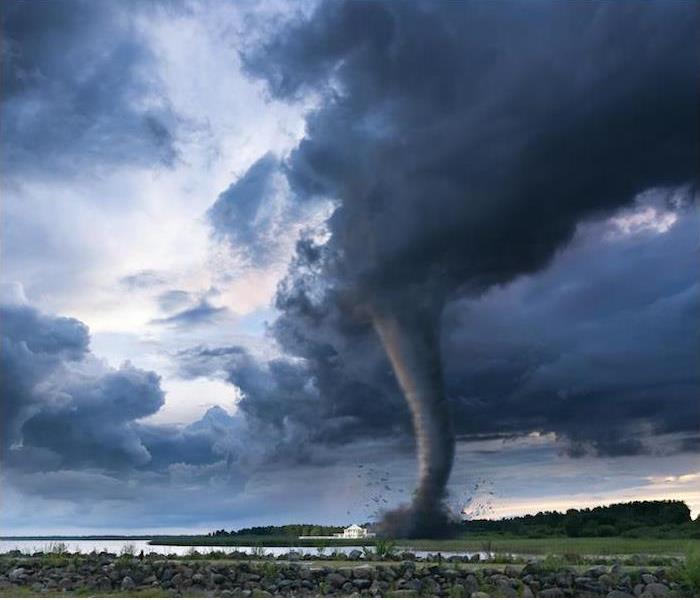 Spring storms can cause major damage to your property. If you experience any damage reach out to SERVPRO of Carrollton.
Spring storms can cause major damage to your property. If you experience any damage reach out to SERVPRO of Carrollton.
Georgia is prone to severe weather of all types but is particularly prone to thunderstorms and tornadoes. All of Georgia is prone to tornadoes throughout the whole year, but they are most likely to occur from March through May and peaking in April.
When there is severe weather, be sure to keep a close eye on how the weather changes and know how to identify tornadoes. Tornadoes are often accompanied by thunderstorms and can develop quickly, so it’s important to have dependable ways to get updates about storms by turning on your radio or TV, or by having notifications on your phone for weather alerts.
A tornado watch means that there hasn’t been a tornado sighting yet, but the weather is favorable for them to happen.
Once a tornado watch is issued, it’s important to stay notified through the tornado warning system in your area, stay tuned to local radio stations or an NOAA radio or have notifications on your mobile device for weather updates.
Most tornado-prone areas have an outdoor siren system. Know how to distinguish between the siren’s warnings for a tornado watch and a tornado warning.
A tornado warning is sent out as soon as a tornado has been spotted or shown on the weather radar. You should seek shelter as soon as a tornado is on the way.
Some tornadoes come quickly and without warning, so it is important to know what to look for. Signs that a tornado may be approaching include:
- A rotating funnel-shaped cloud
- Dark or green-colored sky
- Large, dark, low-lying cloud
- Hail
- Loud roar that can be compared to a train
If a tornado is heading your direction, it’s important to take shelter immediately in the lowest indoor area of whatever building you are in, away from windows. The best places to go are basements and cellars, but hallways or other windowless, centrally located areas are good, too.
If you are outdoors, find a place to take shelter, but if that is not possible, find a ditch and lay face down, covering the back of your head and neck with your hands.
Tornadoes and other severe storms can cause serious damage to your property. If your property is damaged by a storm in any way, SERVPRO of Carrollton has you covered. We are available 24 hours a day and seven days a week so we can begin the restoration process immediately.
Areas we Inspect After Storm Damage
3/23/2022 (Permalink)
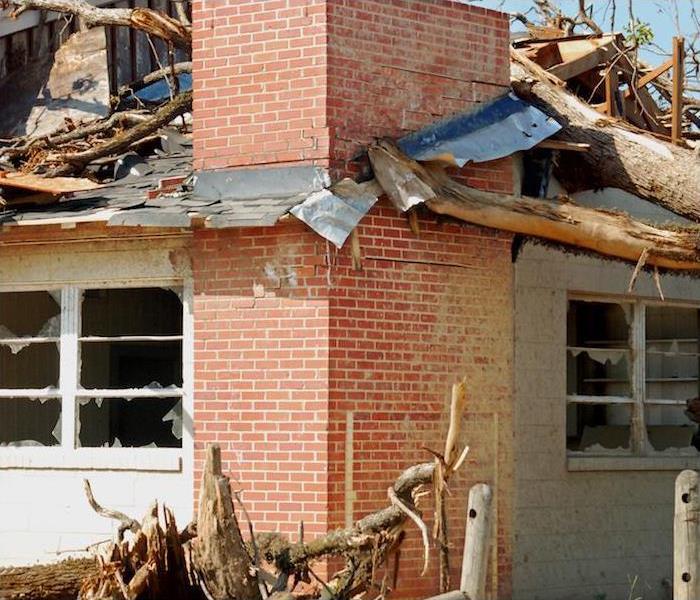 SERVPRO of Carrollton will help you with the whole restoration process after a storm. Call us today.
SERVPRO of Carrollton will help you with the whole restoration process after a storm. Call us today.
You never know when you might suffer property damage due to bad rain, storm damage, wind or debris. In the wake of severe weather, you’ll want to contact SERVPRO to inspect, document and restore any damages to your business for you.
There is a lot you can do to mitigate storm damage, but it’s never completely preventable. Storms can be extremely costly to businesses.
In fact, experts predict that storm and flood damage could cost businesses over $13 billion in 2022.
It’s not always easy for the untrained eye to spot damage after a storm, and damage that goes unnoticed can grow and become even more costly and destructive. When you call SERVPRO to inspect the damage, here are just a few of the main areas we would look for when inspecting your property:
The Roof
Roof damage is one of the most often-occurring kinds of storm-related property damage. We will inspect the roof for loose, curled, missing or cracked shingles.
Additionally, dark patches on asphalt shingles may indicate water damage. Dents or weakened areas on the shingles are indicators of hail storm damage.
We will check for water damage indoors that has sneaked through a damaged roof. Water stains or leaks running down the wall, through a skylight or pooling in the center of the ceiling are further indications that the roof has a leak.
However, not all indications of water damage are obvious. The wisest course of action is to hire an expert to evaluate your house and search for indicators of a leaking roof.
The Exterior
Following a severe storm, you’re likely to find debris scattered around the exterior of your property. These pieces of debris may strike your property, cars or other structures, such as barns or machinery.
We will inspect the whole exterior of your property for loose or broken siding, doors, windows and gutters, among other things. Oftentimes, the exterior can be a significant source of unwanted water leakage that can cause interior water damage and flooding during a storm.
Dents or bends in gutters are often the result of hail, wind and/or debris damage. It is critical to employ an expert to evaluate, record and repair any possible damages precisely and safely.
Windows and Doors
Windows may potentially sustain damage during a severe storm, especially one with heavy winds. Our technicians will inspect the glass for broken panes, shattered glass, chips, scratches and fractures. Additionally, we will search for indicators of damaged seals that allow water to enter through windows and doors.
SERVPRO of Carrollton will help you with the whole restoration process after a disaster, from damage assessment through restoration and rebuilding. Do not hesitate to contact our professionals to get your storm damage emergency repaired immediately and properly.
Can Lightning Cause Serious Property Damage
3/14/2022 (Permalink)
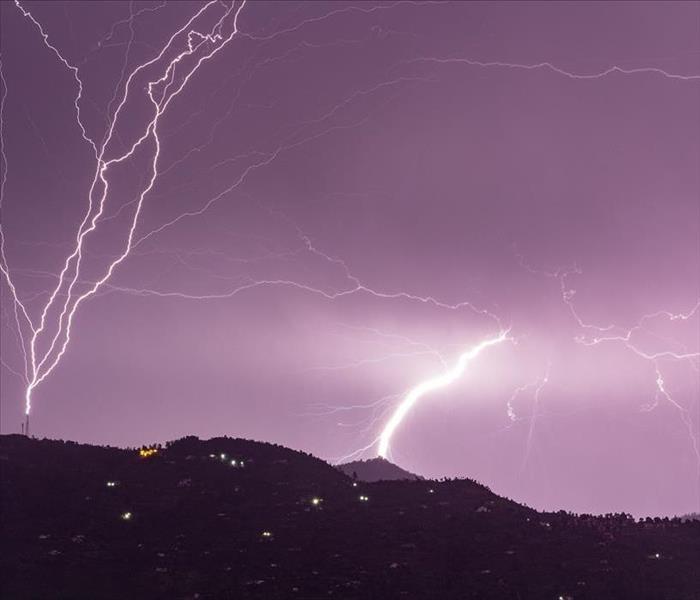 Lightning can cause serious property damage. If you need help repairing your home after lightning damage, contact SERVPRO of Carrollton today.
Lightning can cause serious property damage. If you need help repairing your home after lightning damage, contact SERVPRO of Carrollton today.
Though most rain fronts that pass through our area are no major event, severe weather is something that is entirely different. Severe weather can strike nearly any time of year if conditions are right, and with it, bring heavy rains, high winds, lightning strikes, hail and more—all of which can be rather dangerous.
Many of us are cognizant of the injuries and fatalities that lightning strikes in particular can cause. Around the world, they are responsible for 2,000 deaths each year and many more injuries. However, did you know that lightning can cause serious property damage, too? Below, we will be taking a look at why lightning strikes where it does and the types of damage to be aware of.
Why Does Lightning Strike Where it Does?
The majority of lightning strikes that occur during any given thunderstorm will be from one cloud to another as the electrical charge is transferred from area to area in a storm. However, with all this electricity in the air, lightning can also begin to target the ground, as objects such as buildings, trees and bushes send up sparks to meet it. While it is true that taller objects are more likely to be struck by lightning, it is not a guarantee—lightning will strike anywhere there is a charge, whether it be the ground, a tree or a home.
How Does Lightning Cause Damage?
When lightning strikes a building, it can cause serious property damage as a result. The main ways this can happen are:
* Damage due to fire where lightning strikes. When lightning strikes, it is incredibly hot—and therefore, this heat will be transferred to the impacted target. In many cases, this will cause immediate combustion at the site of the strike.
* Damage due to electrical fires. In addition to the threat that lightning can cause an initial fire where it strikes, it can also cause damage due to electrical fires. Because lightning carries an electric charge, it will travel through a building’s wires once it makes contact—this can cause damage to those wires and lead to an electrical fire, either immediately or later on.
* Water damage due to impact. Even if it does not start a fire, lightning will leave a hole where it strikes a home, which can lead to water damage if it is raining.
*If you have damage to your home, due to lightning or other storm-related causes, we are the team to call. We are here 24/7 to help—get in touch today.*
How Can High Winds Cause Damage During a Storm
3/8/2022 (Permalink)
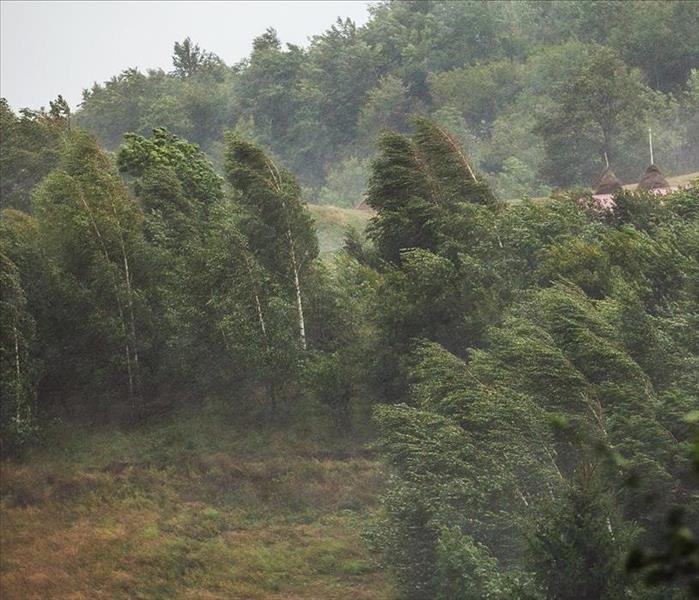 If your home has been damaged due to high winds, call SERVPRO of Carrollton 24 hours a day. ??
If your home has been damaged due to high winds, call SERVPRO of Carrollton 24 hours a day. ??
When it comes to severe weather, there are a lot of ways it can cause harm to an impacted area. More than 75% of deaths pertaining to natural hazards are a result of severe weather, and the property damages caused by storms can be far-reaching and severe. When most people consider severe weather hazards, heavy rains and lightning strikes are probably the first things that come to mind—but unfortunately, straight-line winds can also be significantly damaging to property and people.
Damaging straight-line winds are anything over 50–60 miles per hour, but gusts can reach up to 100 miles per hour if conditions are favorable. When thunderstorms are over an area, they will often cause downdrafts of wind that impact the ground below in several unfavorable ways, which we will look at below.
How Do High Winds Lead to Storm Damage?
**They can rip limbs from trees.** While trees grow to have a certain amount of flex to them in order to withstand the threat of high winds, occasionally, branches will still be ripped from the tree. This is especially true of branches that grow at an odd angle or are less than healthy, which is why trimming trees regularly is so important. When limbs are ripped from trees, they can become high-speed projectiles, crashing into any object or home that ends up in their path.
**They can topple mobile homes.** Because straight-line winds can reach up to 100 miles per hour, they can easily generate an extremely strong force—and in many cases, this can be enough to topple mobile homes or trailers. Even anchored mobile homes can be at risk if winds are strong enough, which puts the people who seek shelter in these homes at serious risk.
**They can make homes more susceptible to water damage.** High winds and water damage often go hand in hand, because winds can cause damage to homes that make them more susceptible to water damage. Projectiles carried on the wind can shatter windows, which will then let in rain. Additionally, high winds can damage roofing shingles, flashing and other exterior elements of the home designed to keep moisture out, resulting in hidden leaks that can be costly.
*If you have storm damage to your home, you can count on our team to help. Get in touch today to learn more about our restoration processes—we’re here 24/7 to help.*
The Dangers That Occur When Severe Weather Strikes
3/2/2022 (Permalink)
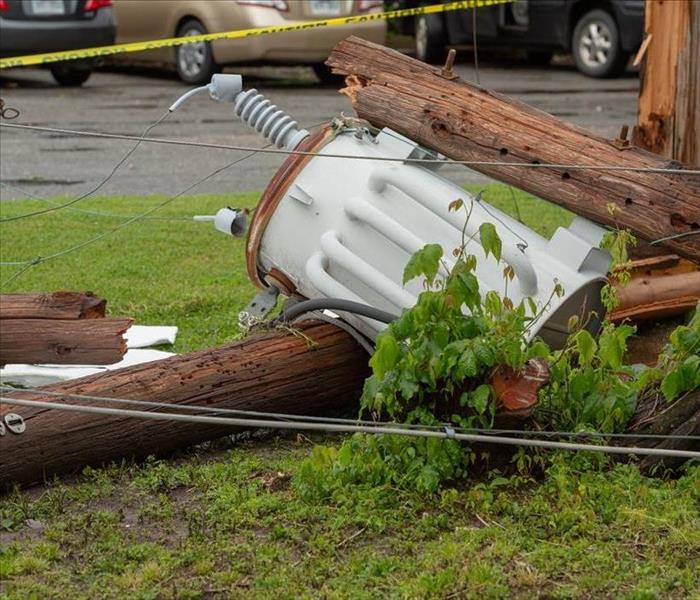 If your home is damaged from flash floods, lightning, or hail call SERVPRO of Carrollton 24 hours a day!
If your home is damaged from flash floods, lightning, or hail call SERVPRO of Carrollton 24 hours a day!
More than simply being an inconvenience, severe weather can cause serious damage in a variety of ways. In addition to being dangerous enough to cause personal injury to anyone who has not sought out adequate shelter, severe weather can also cause property damage to any homes or businesses in the line of the storm.
While severe weather can often move through an area without causing much damage, any time it is a possibility, it is wise to be vigilant so you know when to seek safe shelter to protect your family. Below, we will be taking a look at the types of hazards that happen during severe weather so you can be better prepared for their occurrence.
The Types of Hazards That Occur During Severe Weather
**Flash flooding threats.** Flash flooding is a serious problem, in part because it is quite unpredictable—hence the term “flash.” Flash flooding is more common in low-lying areas, but it can happen anywhere that receives a heavy amount of rainfall in a short period of time. Rapidly rising creeks and ponds are often sources of flash flooding, but even overwhelmed storm drains can become backed-up and impact an area.
**Fire hazards from lightning strikes.** Lightning strikes can occur any time there is a thunderstorm, and they are responsible for around 2,000 deaths per year throughout the world. In addition to being dangerous for anyone caught outside, lightning strikes can also introduce serious fire risks when they strike homes. Lightning can start a fire when it hits a home, due to the intense amount of heat it transfers, but it can also cause electrical fires as it travels through (and damages) a home’s wires on its way to seeking grounding.
**Damage due to high winds and hail.** Severe weather is often accompanied by high, straight-line winds up to 100 miles per hour—which as you can imagine, can cause serious damage. High winds can break off tree branches and turn them into projectiles, which can shatter windows, damage roofs and make homes susceptible to water damage as a result of being vulnerable to heavy rains.
*If severe weather strikes your home, you can depend on us to help. We have a team of storm restoration experts on hand 24/7—contact us today to learn more.*
The Most Common Roof Problems You’re Likely to Encounter
2/2/2022 (Permalink)
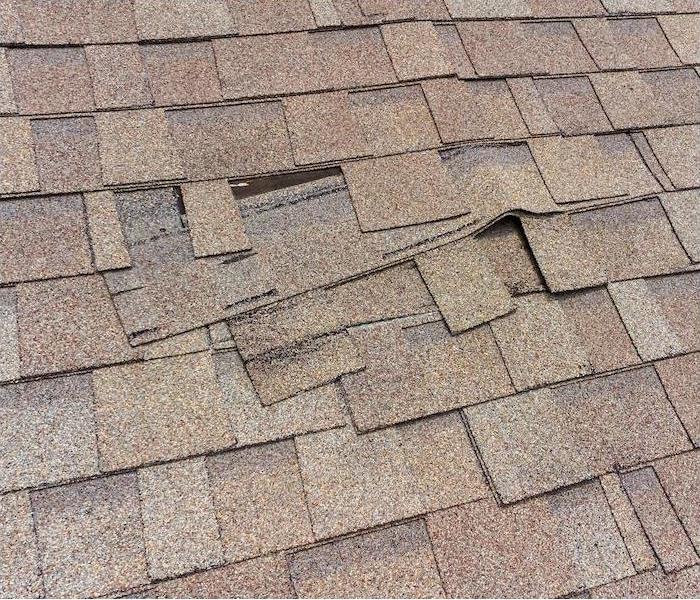 Roof care is home care, and leak prevention is the name of the game. If you find any signs of damage to your property, call SERVPRO of Carrollton.
Roof care is home care, and leak prevention is the name of the game. If you find any signs of damage to your property, call SERVPRO of Carrollton.
One of the sneakiest water damage sources in your home is actually on your home. Your roof regularly takes a beating from weather, sun, wind, rain and more, and it does a great job overall. If we were talking percentages, we’d be looking at Hank-Aaron-meets-Ted-Williams-type numbers.
But roofs are also one of the last places we tend to check for leaks, and thusly, one of the last places we catch leaks before they become a problem.
Make this your year to change all that. Keeping an eye on these problem areas can keep water from sneaking into your home through cracks and gaps in the roof.
Storm damage. Wind, hail and other environmental factors can damage your roof during a storm. No matter the season, your roof takes a pounding from storms, and you should always inspect your roof visually after a major storm, at the very least. If you suspect anything negative may have occurred, play it safe and let a pro examine it.
Falling branches and tree damage. Overhanging branches can crack and fall, but they can also rub away the top layer of your shingles over time as they sway with the wind. Trimming trees and being mindful of their proximity to your roof can help you avoid bad shingles and subsequent leaks.
Flashing. Your roof likely already has holes in it, but they’re the kind you have to have. Chimneys, vent pipes, skylights and even HVAC systems all come through your roof for ventilation. If the flashing is poorly installed, or if it simply wears down over time, it can cause seams in your roof and pull shingles and tiles off their proper alignment. Flashing may also need to be resealed from time to time.
Mold. Those dark streaks and patches on your roof are easy to ignore, but they’re really patches of mold—and that’s never good. There are many reasons to get rid of mold whenever and wherever you see it, but in the case of your roof, that mold can eventually eat away at your roofing material, which can let water in.
Gutters. While technically roof-adjacent, this one certainly needs attention as well. Keeping your gutters free of debris and buildup can stop water from damming up and flowing into your house by getting under your shingles.
Time. The truth is, your roof has a life expectancy, and even within that window it’s likely to develop needs that you can’t see from the ground or as an amateur. An annual roof checkup is recommended in order to keep your roof performing at its peak. A professional can identify problems that are, and some that have not yet come to pass.
Roof care is home care, and leak prevention is the name of the game. If water damage becomes an unexpected part of your home ownership experience, contact SERVPRO to get things cleaned up and restored.
Why to Choose SERVPRO When Your Home Needs Reconstruction
12/20/2021 (Permalink)
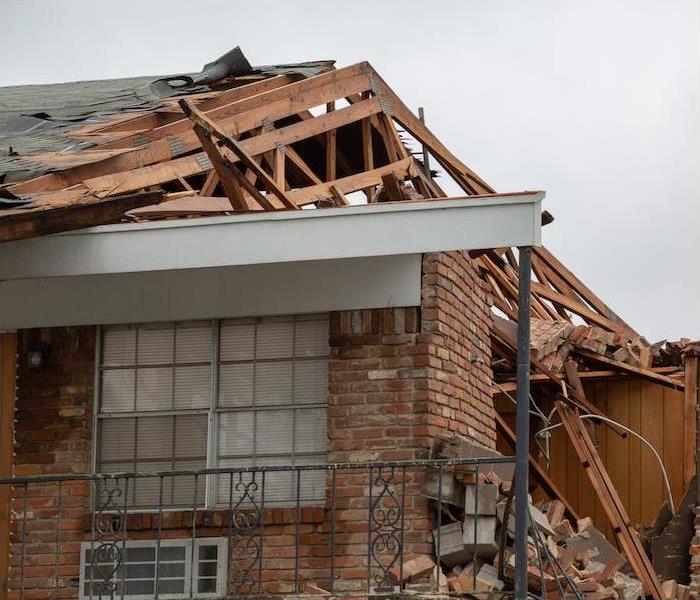 When damage happens at home, we’re ready to jump into action. Contact SERVPRO of Carrollton to get help right away.
When damage happens at home, we’re ready to jump into action. Contact SERVPRO of Carrollton to get help right away.
Not all emergencies are created equal. Sometimes the extent of a restoration need is to have carpet professionally dried, furniture restored or mild smoke smell removed—all things that are certainly within our capability.
But some emergencies take a bigger chunk out of your life, ruining whole areas of your home—your subfloor, drywall and even your framework. It’s in these times that you’ll be glad to know you’ve got a team on your side who can not only handle the cleanup, but also perform any necessary reconstruction, to restore your home to its original, preloss state.
Our first aim is restoration. We want you to be able to keep your original possessions, and we’ve got both modern and time-tested techniques to get them dried, sanitized and ready for use again.
But when something more is needed—when an electrical fire eats away your walls from the inside, for example—we can take care of everything, start to finish.
When you choose SERVPRO of Carrollton for reconstruction, that means all your needs are cared for by one team, with clear communication, synergy and expertise. You’ll have a faster, easier and more effective recovery time, plus the peace of mind knowing it’s all being handled by the industry leader with over 50 years’ experience in the field. And your insurance company will love you for keeping things simple.
Reconstruction requires expertise, because existing parts of your home have to be properly fitted to match reconstructed areas, which are built in or rebuilt to replace damaged ones. It’s not an easy task to make it look natural and seamless, but SERVPRO of Carrollton is up for the challenge.
Considering the widespread damage that can happen to your home because of a few inches of floodwater, it’s easy to see why reconstruction can become necessary. But you can rest easy knowing that should the need arise, your friends at SERVPRO have the expertise, tools and teams available around the clock to get your cleanup and reconstruction handled quickly, safely and completely.
When damage happens at home, we’re ready to jump into action. Contact SERVPRO when reconstruction and recovery are needed after water damage, fire or mold outbreak.
Tree Hazards Are a Serious but Overlooked Storm Danger
12/13/2021 (Permalink)
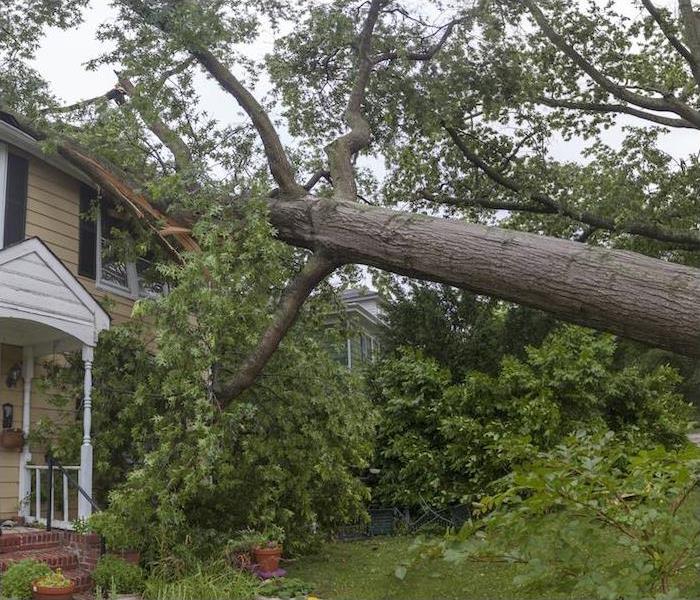 When storms cause issues, we make it our priority to make things right again. Contact SERVPRO of Fayette/S. Fulton today.
When storms cause issues, we make it our priority to make things right again. Contact SERVPRO of Fayette/S. Fulton today.
There’s an assailant in your yard. An attacker, or possibly even a gang of them—a gaggle of malfeasants waiting for the right moment to strike.
We’re talking, of course, about your trees. Sure, they look innocent enough—they mostly stand around, though occasionally they may wave. But they’re waiting on a signal, ready to cause damage to your property or your home with a strong wind or a bolt of lightning.
Storm-related tree damage is a very real threat, and yet it’s something we often don’t prepare for well. 2020 alone saw more than 16,000 reports of damage from thunderstorm winds, and many of those were downed trees. Severe thunderstorms and extreme weather events often carry winds upwards of 60 miles per hour, which is enough to down a tree.
But of course, you love your trees and the shade, oxygen and beauty they provide, and you wouldn’t want to see them gone. So let’s look at what you can do to avoid potential damage to and from them in a heavy storm.
The Signs of a Hazard TreeA hazard tree is much more likely to fall or break in heavy wind or storms. If you can see that a tree is a risk, you can take action to have it dealt with on your own terms, before a storm strikes.
Check the trunk. Some signs of decay are observable. Wood can weaken as it ages, and decaying tree tissues become inflexible and are prone to breakage. You may see external signs such as seams, cracks and dead, stubby branches, which can indicate decay inside the tree. You may also notice cankers or wounds, which grow in size over time and make a tree more likely to fail.
Check the crown. Irregularly shaped treetops, such as lopsided ones or crowns with v-shaped forks, may be signs a tree is unhealthy and likely to fail in a storm. Trees that lean more than about 15 degrees should be removed, as that kind of lean indicates the uprooting process may have already begun.
Check the roots. If your tree’s roots aren’t healthy, you don’t have a healthy tree, period. The more root damage your tree has, the more likely it is to come up out of the ground under heavy wind or strain. Dwarfed tree growth, off-color leaves and thin crowns can all be outward signs of unhealthy roots.
The danger of any of these hazards is increased if a tree is hanging over your roof, vehicle or other property, because a fall would cause much more damage. There are treatments and prevention methods you can try if you notice an unhealthy tree in the yard, but it’s best to take care of it as soon as possible, to minimize the chance that it could fall and cause harm.
When storms cause issues, we make it our priority to make things right again. Contact SERVPRO today to get help 24⁄7 in emergencies.
Resilience and Recovery After a Tornado
9/4/2021 (Permalink)
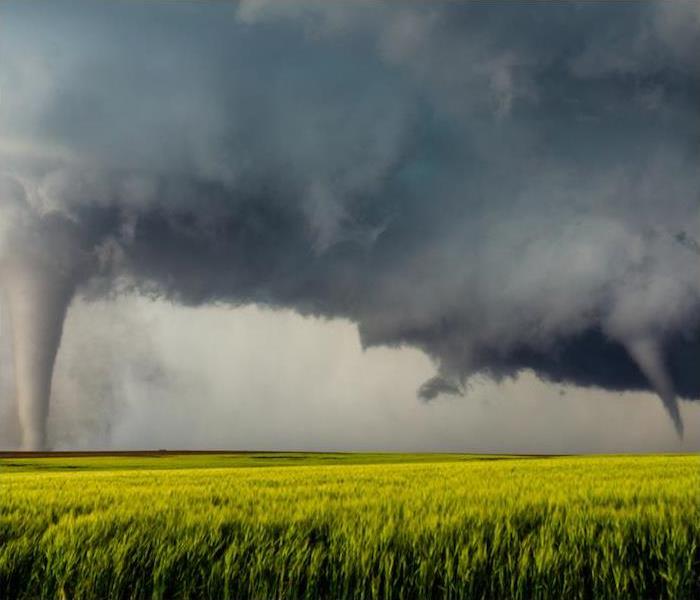 When storms strike, SERVPRO of Carrollton is here to help in your recovery process. Call us if you experience any damage.
When storms strike, SERVPRO of Carrollton is here to help in your recovery process. Call us if you experience any damage.
The devastating EF-4 tornado that ripped through our area in March is still fresh in the minds of everyone in Troup County, and its effects can be seen everywhere you look.
It will be a long time before things fully return to normal, especially for the residents who lost their homes and business owners whose buildings were destroyed and damaged heavily.
But the community has banded together in beautiful ways, and people have been glad to give time and resources to help one another in times of crisis and need. Even outside help, like the 10-week, half-million dollar cleanup investment by Home Depot Foundation, has made an impact in the recovery in Newnan, Lagrange and surrounding areas.
Rebuilding for the Future
There are ways we can rebuild and use federal disaster funding to create a city that is more prepared for these kinds of events in the future and more resilient when they occur. There are many applications and sides to this kind of sweeping process.
Some of them are political and governmental, but some are practical and educational. Let’s look at a very broad overview of some ways we can rebuild with the future in mind.
Realism and Education
How many times have we heard a meteorologist predict a storm and blown it off as an afterthought? Anyone who was impacted by March’s tornado will certainly carry a fresh perspective on the importance of paying attention and heeding local warnings, but we would all do well to stop assuming we will be exempted from potential harm in storms.
Did you know that, though the federal government gives disaster assistance, it only funds about 20% of the recovery for what you lose in a flood, versus approximately 85% recovery from flood insurance? Yet a huge number of people choose not to carry flood insurance, in some cases because their insurance companies are not accurately reflecting their flood plain status due to outdated resources.
And did you know that modern, storm-resilient construction only costs about 10% more than traditional construction? But many builders require you to opt in if you want it done, rather than offering it as a base option, because they want to hand you a lower bid.
Thinking resilience-first can save you a lot of money and hassle in the future, and even increase the value of your home should you sell it in the future.
Part of building a storm-resilient city requires that we take our own safety seriously and educate ourselves on risks and prevention methods. We can’t prevent storms, but we can inch ourselves forward toward communities that are safer, more prepared and more durable when they come.
When storms strike, SERVPRO is here to help in your recovery process, and we have a restoration-first methodology that means you get to keep more of what you value. Click or call today to find out how we can serve you.
Dangers of Extreme Cold
8/24/2021 (Permalink)
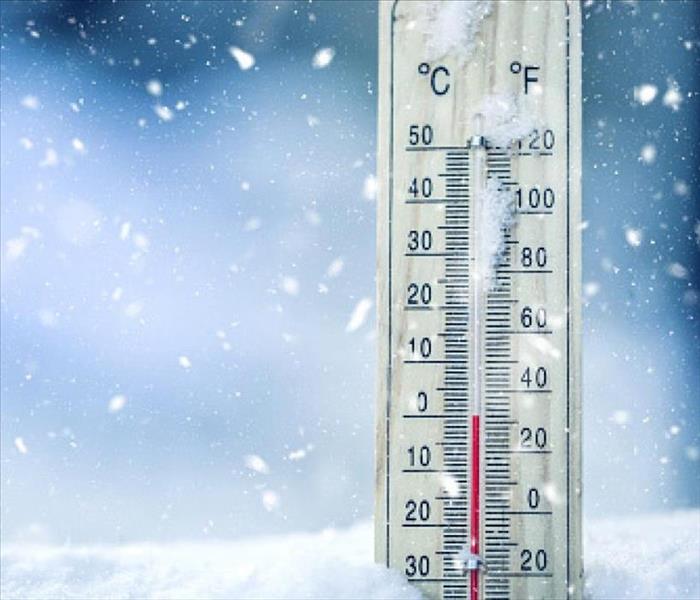 It is important to be aware of the effect extremely cold temperatures can have on you.
It is important to be aware of the effect extremely cold temperatures can have on you.
While your home can get damaged due to winter weather and extreme cold, your personal health is also at risk.
Thirty-five people died due to extreme cold in 2019.
It is important to be aware of the effect extremely cold temperatures can have on you. The two main conditions to be aware of are frostbite and hypothermia.
Frostbite is caused when your skin is exposed to extremely cold temperatures. Physical symptoms are white or grayish-yellow skin, skin that feels unusually firm, or waxy numbness.
Hypothermia is when your body temperature falls to an abnormally low temperature, caused from long exposure to cold weather. Signs of hypothermia include shivering, exhaustion, confusion, fumbling hands, memory loss, slurred speech, and drowsiness. If someone’s body temperature is below 95°F, seek medical attention immediately.
To avoid these conditions, stay indoors if possible. If not, dress warm in layers and try to keep dry.
Tips for Preparing Your Business for an Emergency Situation
7/20/2021 (Permalink)
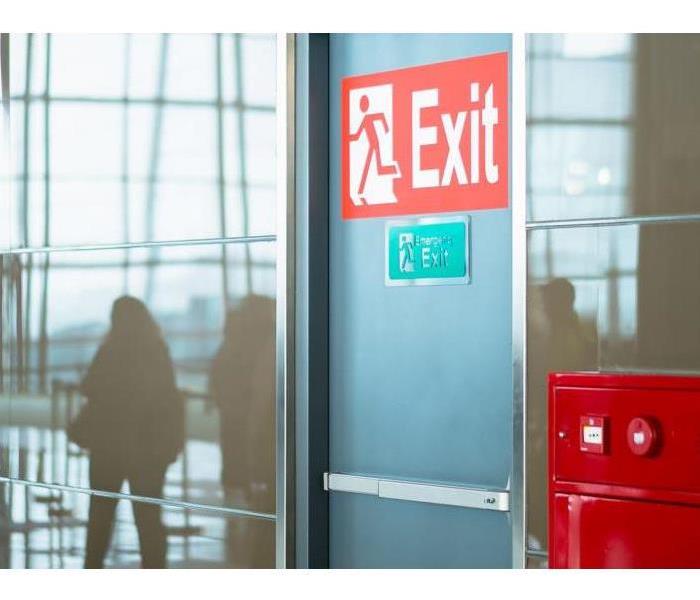 If your business is damaged due to a disaster or an emergency, SERVPRO of Carrollton is here for you.
If your business is damaged due to a disaster or an emergency, SERVPRO of Carrollton is here for you.
If you own your own business, you understand the importance of planning ahead to set yourself up for success—but have you considered the need to plan ahead for an emergency scenario? The frequency with which disasters occur continues to rise, and being prepared for any scenario is the best defense business owners have against them.
Understanding how to prepare your business can help you recover far more quickly after an emergency and get your doors reopened faster after a disaster.
How to Prepare Your Business for an Emergency
Review the details of your insurance policy. The average commercial insurance policy provides many standard coverages, but it also leaves quite a bit of scenarios out, requiring business owners to purchase additional coverage for situations such as floods, income interruption and gaps in your policy. It is smart to review your insurance policy through the lens of disaster preparedness planning to learn about any gaps in coverage you may have.
Make sure your documents are backed up and stored well. Having the right documentation on hand after a disaster will make the recovery process much easier, but have you considered the correct way to store them? Many files are digital now, so you should make sure you have a cloud backup or hard copy in case your computer gets damaged in a disaster. If you have physical documents you may need, make copies of those and store them securely in a secondary location.
Be sure you have an evacuation plan. If a flood or other natural disaster is incoming, officials will normally recommend a rapid evacuation so that everyone can get to safety. Be sure you have an evacuation plan that includes well-marked evacuation routes and a headcount system to make sure everyone is accounted for, and make certain that you have rehearsed often with staff. This serves to reduce panic in the moment as well as your overall liability, and equips everyone to move to safety calmly and quickly in an emergency.
If your business is damaged due to a disaster or an emergency, we are here for you. You can contact us any time to learn more about commercial restoration and how we can help.
Lightning Safety for Outdoor Workers
7/5/2021 (Permalink)
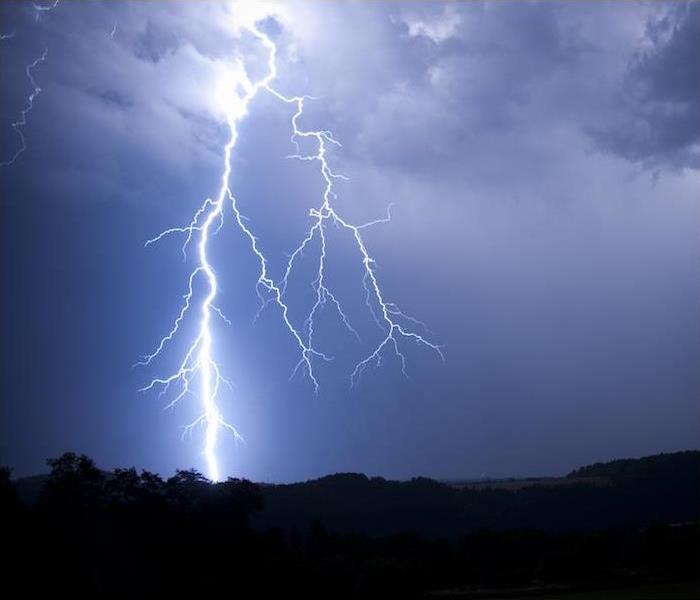 If you have any damage from a storm and/or water, call SERVPRO of Carrollton. We are your local restoration team.
If you have any damage from a storm and/or water, call SERVPRO of Carrollton. We are your local restoration team.
Lightning as an occupational hazard is often an afterthought, but it shouldn’t be. An average of 47 of all occupations require outdoor work at some point in the day.
That means almost half the American workforce is outside for some period of time every day, and many fields require a much higher percentage of outdoor time. When thunderstorms arise, those workers are at elevated risk of lightning strikes and other dangers.
Safety Best Practices for Outdoor Work
OSHA and NOAA recommend several broad safety practices for business who have workers outdoors. These include:
Being informed by NOAA weather reports. Employers and supervisors should be aware of reported and upcoming weather events before sending workers outside. Weather.gov and local outlets will make weather updates as inclement weather comes toward the area. Employers should consider rescheduling events, jobs or activities outdoors if thunderstorms are headed in. Darkening clouds and increased wind speeds can also be indicators of dangers weather afoot.
Seeking shelter in buildings. Workers should be informed before heading to outdoor jobs what nearby buildings they should seek out for shelter if they hear thunder or see lightning. These buildings should be fully enclosed and outfitted with plumbing and electricity. Once inside, workers should remain indoors at least a half hour after the last peal of thunder before returning to work. Remember, the fact that you’re not getting rained on doesn’t mean you’re not in danger—lightning can strike up to 10 miles away from the nearest rainfall.
Using vehicles as a second option. If safe buildings aren’t accessible, workers should be guided to hard-top vehicles with all windows rolled up, where they should remain for the duration of the storm and 30 minutes after thunder stops.
Practicing phone safety. Corded phones are still used in many buildings, but they shouldn’t be used in a building during a thunderstorm except in emergency situations. Cell phones are safe to use.
Business owners and supervisors should also have an emergency action plan for storms in place, with written protocols for lightning safety outlining company storm procedures. Lightning and storm safety training should also be implemented, so that workers know where to go in emergencies and what to expect regarding communication when storms approach.
We’re here to help with any damage done by thunderstorms, whether it be from water, fire or lightning. Call or click today to experience the SERVPRO difference.




 24/7 Emergency Service
24/7 Emergency Service

















